
Spare bicycle parts, a restless spirit, and a willing "guinea pig" can make for a dangerous combination. In her latest reincarnation,
Marianne sports
VO Belleville handlebars and
Dia Compe inverse brake levers - a practice run to determine how a similar set-up would feel on the
Royal H. mixte.
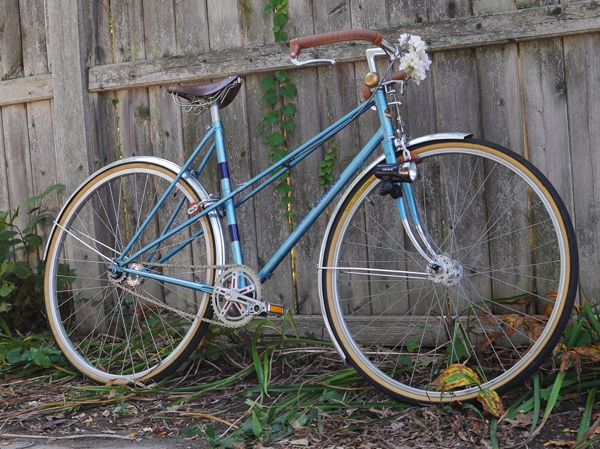
Here are the bars and levers in all of their French glory - on a
Motobecane mixte with an
Ideale saddle.

The
Belleville handlebars are similar to the
Porteur handlebars shown here. Both are a classic style of upright bars found on vintage French city bicycles. These bars are narrow, with long gripping areas that are nearly parallel to each other - placing the rider's hands in a position similar to holding a tray. The
Bellevilles are 5cm narrower than the
Porteurs (43cm vs 48cm) and are completely straight across the front (whereas the Porteurs have a slight forward sweep).
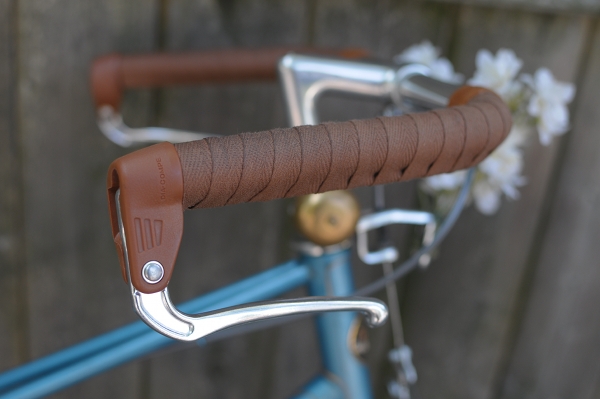
It is typical to see handlebars like this fitted with inverse brake levers. My assumption is that this is done to maximise the gripping area of the bars. Because the levers are installed at the ends, there are no interruptions along the handlebar's surface and the cyclist is free to move their hands pretty much along the entire bar.

The inverse brake levers you will find today are most likely either
Tektro or
Dia Compe. Here I have installed the latter, and you can see that their brown rubbery tips go nicely with twined handlebars. It surprised me to learn that some dislike the
Dia Compes because of the brown tips and prefer the
Tektro levers instead - which are all-metal. To me, the rubbery surface felt nice, but I suppose it isa matter of personal preference. If you have used either of these levers, I'd like to hear your thoughts.
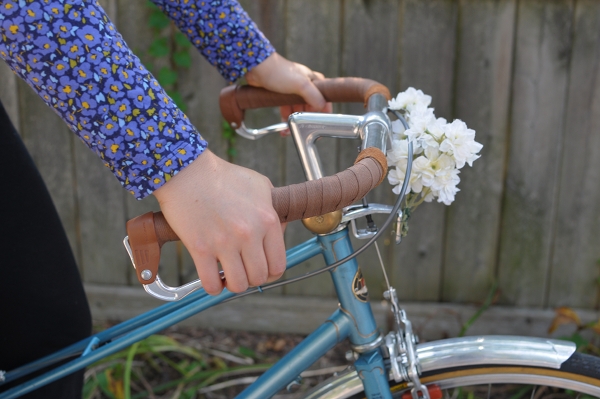
Braking with inverse levers. I have found that I am able to get pretty good leverage almost no matter where I hold my hand along the bar, with the exception of the very front.

Can't brake from here, near the corners. But if I move my hands 1-2 inches back, it will work. This set-up is amazingly versatile in terms of the hand positions it allows.

The inverse levers are set back from the bars far enough so that they do not interfere with the grip. You can see in the pictures that they are nowhere near my knuckles. Truly a neat design.
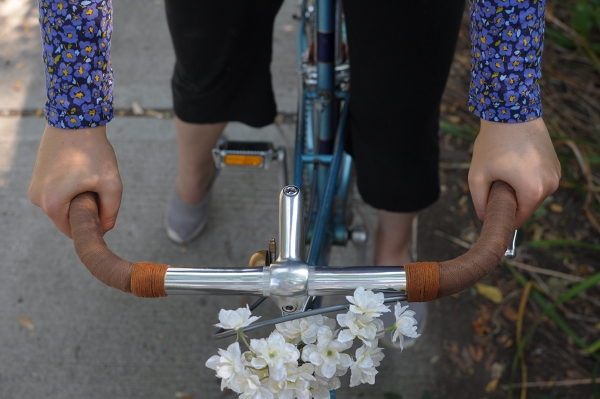
If you are curious about this type of French set up, both the bars and the levers are surprisingly inexpensive. You will like them if you are a fan of narrow handlebars, and if you prefer to hold your hands to the sides rather than flared out or straight in front of you. I certainly fit that description, so both the
Belleville and the
Porteur handlebars feel as if they were made just for me. The super-wide Albatross bars were comfortable enough, but with the
Bellevilles and the
Porteurs I get that "spot on!" feeling. I also think that they are better match for French bicycles - especially for the
Motobecane's aggressive handling.
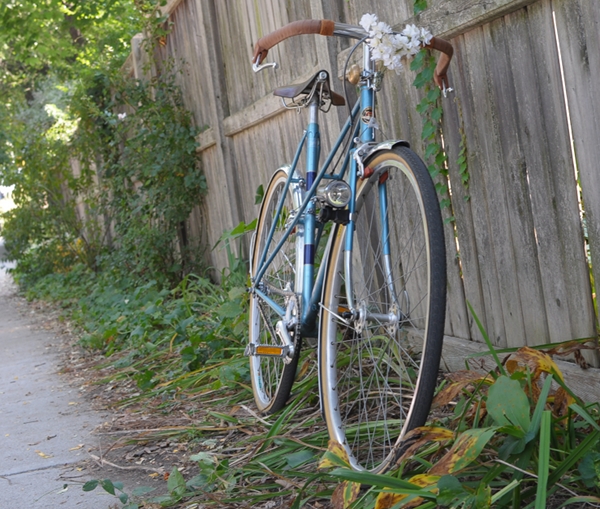
I will pause and confess here, that this is the last change I will be making to
Marianne...because she no longer belongs to me. Yes, I did sell her after all - to a lovely local woman whose acquaintance I had the pleasure of making this morning. Riding the
Motobecane with the French handlebars and inverse levers yesterday, I finally felt that this bicycle was "perfect" and experienced a calm sense of satisfaction - not dissimilar to how I feel when a painting is finally "finished" or when a photograph looks just right. And after that, it finally felt appropriate to let her go. I hope the new owner enjoys her as much as I hope to enjoy my
Royal H. mixte - which I will most definitely fit with a similar handlebar set-up.
Oh - and if anybody wants some
Nitto Albatross bars (the alloy version) or
VO Milan bars, drop me a line. Thankfully, I have no more "spare" bicycles to put them on.


 The North Rim has experienced several fires in the past few years and evidence of those fires is everywhere. The Park Service is taking a mostly hands-off approach to the burned out trees and letting nature take her course in rejuvenating the area.
The North Rim has experienced several fires in the past few years and evidence of those fires is everywhere. The Park Service is taking a mostly hands-off approach to the burned out trees and letting nature take her course in rejuvenating the area. One of the big differences between the North and South Rim are the forests of pine trees in the north. Though only a few miles separate the two rims the climate is completely different.
One of the big differences between the North and South Rim are the forests of pine trees in the north. Though only a few miles separate the two rims the climate is completely different. Looking south from the overlook on the Uncle Jim Trail. The North Kaibab Trail is barely visible on the lower portions of the canyon walls.
Looking south from the overlook on the Uncle Jim Trail. The North Kaibab Trail is barely visible on the lower portions of the canyon walls. The upper portion of the North Kaibab Trail, the beginning of which is in the upper right corner. Appearances are deceiving; it is much steeper than it looks.
The upper portion of the North Kaibab Trail, the beginning of which is in the upper right corner. Appearances are deceiving; it is much steeper than it looks. The trail disappears from view in the middle portion of the canyon then appears again on the sides of the canyon walls.
The trail disappears from view in the middle portion of the canyon then appears again on the sides of the canyon walls.
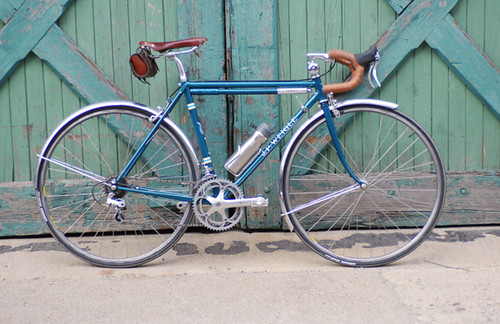
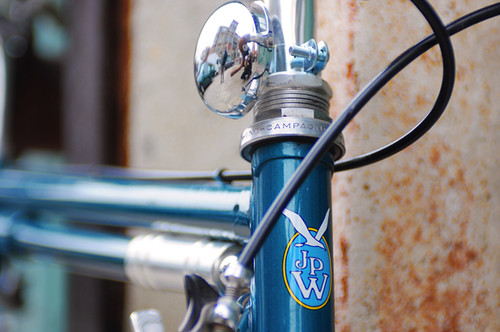
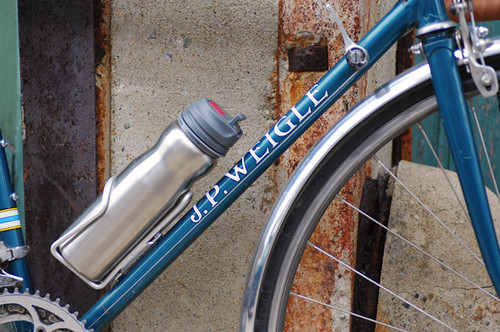



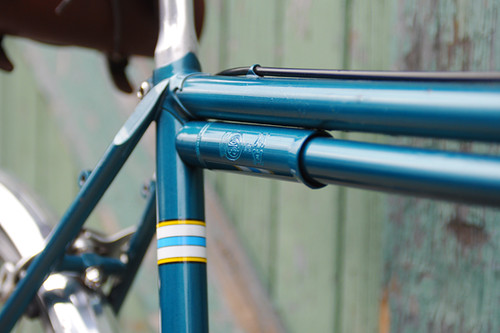


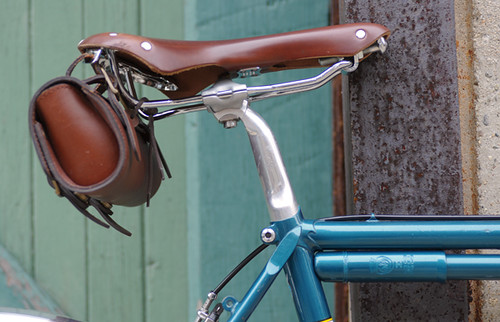


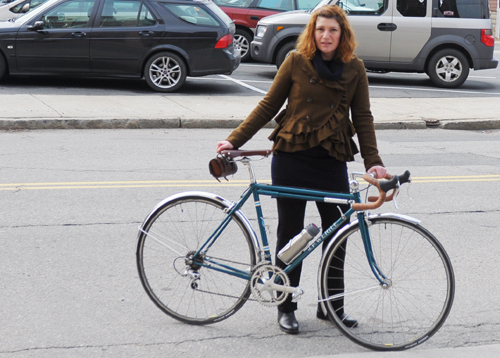
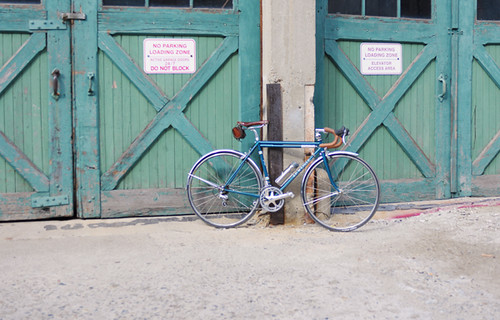
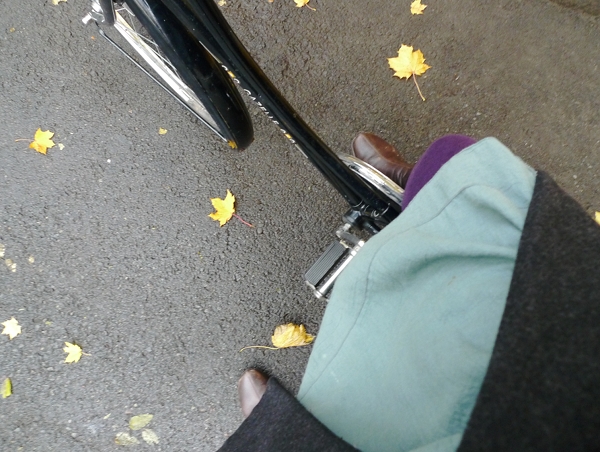 I tend to think of myself as having begun cycling when I got into it as an adult. But technically, that is not so. I learned to ride a bike when I was a child, and rode one all through junior high and most of high school. There was a nice post today on ecovelo, where Alan mentioned having "lived on his bike" as a kid, and in a sense it was similar for me. My friends and I did not race each other through wheatfields or pop wheelies, but we did use our bikes to get around our small town. Even once old enough to drive, most of us somehow still stuck with bicycles: It just seemed easier and even kept us off our parents' radar (for example, they could not look at the odometer to determine whether we had gone out when we were told not to).
I tend to think of myself as having begun cycling when I got into it as an adult. But technically, that is not so. I learned to ride a bike when I was a child, and rode one all through junior high and most of high school. There was a nice post today on ecovelo, where Alan mentioned having "lived on his bike" as a kid, and in a sense it was similar for me. My friends and I did not race each other through wheatfields or pop wheelies, but we did use our bikes to get around our small town. Even once old enough to drive, most of us somehow still stuck with bicycles: It just seemed easier and even kept us off our parents' radar (for example, they could not look at the odometer to determine whether we had gone out when we were told not to).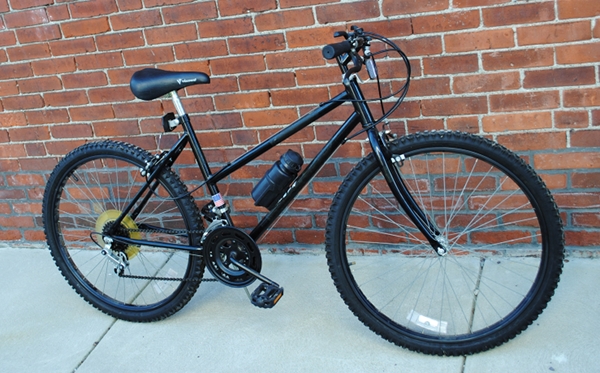 But during all those years of riding bikes as a child and teenager, I knew absolutely nothing about "technique." At some point I was given a 2-wheel bike, and I used it as a push-bike for a few laps around the park until suddenly I was able to pedal without the bike falling over. To me, that meant that I was pretty much done learning "technique." In the years that followed, I rode with the saddle low, never learned how to start and stop "properly" or to pedal while standing, and was not aware that turning involved leaning and balancing, rather than using the handlebars. Heck, I never even learned how to shift gears, because the shifters on my low-end bike were jammed!
But during all those years of riding bikes as a child and teenager, I knew absolutely nothing about "technique." At some point I was given a 2-wheel bike, and I used it as a push-bike for a few laps around the park until suddenly I was able to pedal without the bike falling over. To me, that meant that I was pretty much done learning "technique." In the years that followed, I rode with the saddle low, never learned how to start and stop "properly" or to pedal while standing, and was not aware that turning involved leaning and balancing, rather than using the handlebars. Heck, I never even learned how to shift gears, because the shifters on my low-end bike were jammed!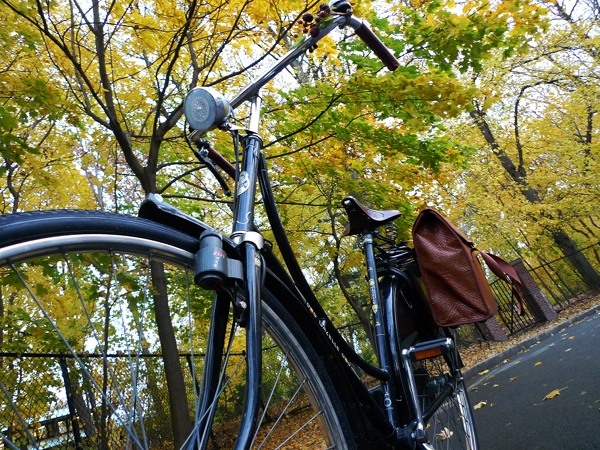 When I think about how it feels to cycle today - and particularly, how it felt when I first started doing it as an adult - I am confused and frustrated by all those younger years spent riding a bike without knowing how to do it properly. It's odd that I did not naturally pick up any skills what so ever during that time. (How can that be? Surely no one is that unathletic?) Moreover, my friends must have been just as clueless, because no one ever made fun of me or told me I was "doing it wrong." And it's frustrating that those skills were so much easier to learn as a child than as an adult - so by not having learned them early, I am at a disadvantage that may take me some effort to overcome.
When I think about how it feels to cycle today - and particularly, how it felt when I first started doing it as an adult - I am confused and frustrated by all those younger years spent riding a bike without knowing how to do it properly. It's odd that I did not naturally pick up any skills what so ever during that time. (How can that be? Surely no one is that unathletic?) Moreover, my friends must have been just as clueless, because no one ever made fun of me or told me I was "doing it wrong." And it's frustrating that those skills were so much easier to learn as a child than as an adult - so by not having learned them early, I am at a disadvantage that may take me some effort to overcome.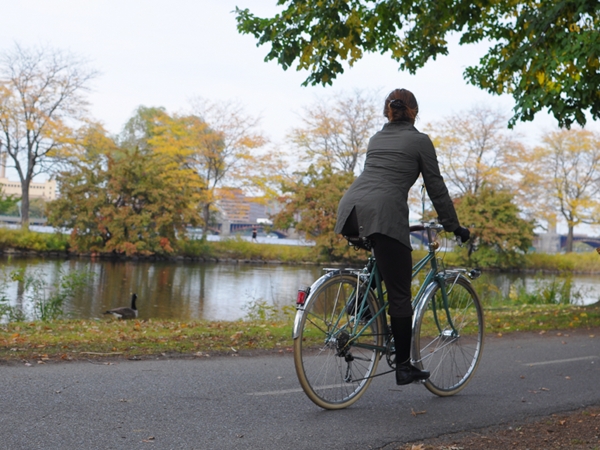 As for saddle height, it is an ongoing fiasco: It took over a year of gradually raising it until I was able to have it at more or less the height where it needs to be for good leg extension... But I still cannot mount a bicycle properly and have to do a graceless little lean-and-hoist maneuver to get myself onto that raised saddle. Terrified of falling, I am highly resistant to being taught, and watching videos of others doing it over and over has not helped. At least I am now finally able to pedal while standing: After months of riding fixed gear, I finally got it (at first I could do it only on the fixed gear, then the skill gradually transferred onto freewheel bikes). I have to say, that was not easy for me to "get". In my head I understood what to do, but my body refused to balance.
As for saddle height, it is an ongoing fiasco: It took over a year of gradually raising it until I was able to have it at more or less the height where it needs to be for good leg extension... But I still cannot mount a bicycle properly and have to do a graceless little lean-and-hoist maneuver to get myself onto that raised saddle. Terrified of falling, I am highly resistant to being taught, and watching videos of others doing it over and over has not helped. At least I am now finally able to pedal while standing: After months of riding fixed gear, I finally got it (at first I could do it only on the fixed gear, then the skill gradually transferred onto freewheel bikes). I have to say, that was not easy for me to "get". In my head I understood what to do, but my body refused to balance.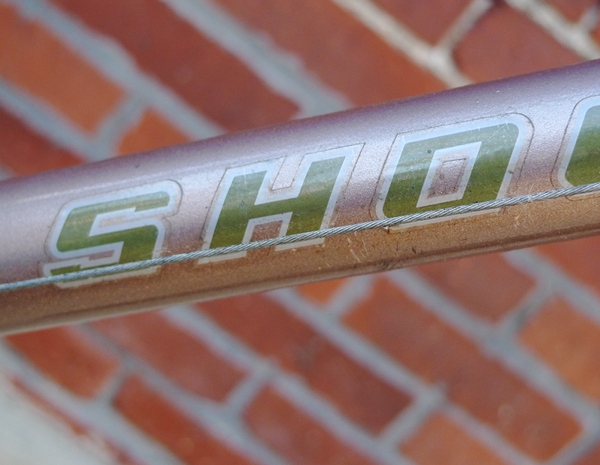 The house is full of excitement, as the Bicycle Fairy has visited me again!It was a Japanese bicycle fairy. She spoke through an interpreter, and these were her words:
The house is full of excitement, as the Bicycle Fairy has visited me again!It was a Japanese bicycle fairy. She spoke through an interpreter, and these were her words: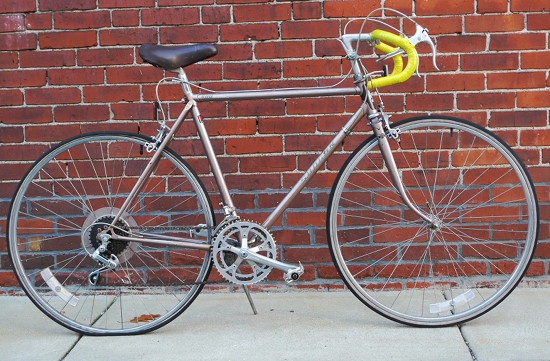 And indeed I knew exactly what to do once I saw this neglected beauty, her frame an enchanting mixture of mauve and champagne. She is a 1980'sShogun- a Japanese touring bike in double butted cromoly steel.
And indeed I knew exactly what to do once I saw this neglected beauty, her frame an enchanting mixture of mauve and champagne. She is a 1980'sShogun- a Japanese touring bike in double butted cromoly steel. My plan is to give this bicycle a make-over, to learn a thing or two about vintage Japanese bikes in the process, and then to find a new home for it in the spring.I will keep a lot of its vintage goodness, but will replace some of the components with my own mix that I have found especially comfortable and easy to use - and I think that other women will too.As I begin to work on the bike, I will explain what it is I am changing about it, and why. And I will also post a test ride report soon, comparing it to other vintage roadbikes that I have tried.I am excited about this project, because I think this bicycle is justperfectfor a woman who would like to try a roadbike but is not confident about her skills. The right bike can make all the difference!
My plan is to give this bicycle a make-over, to learn a thing or two about vintage Japanese bikes in the process, and then to find a new home for it in the spring.I will keep a lot of its vintage goodness, but will replace some of the components with my own mix that I have found especially comfortable and easy to use - and I think that other women will too.As I begin to work on the bike, I will explain what it is I am changing about it, and why. And I will also post a test ride report soon, comparing it to other vintage roadbikes that I have tried.I am excited about this project, because I think this bicycle is justperfectfor a woman who would like to try a roadbike but is not confident about her skills. The right bike can make all the difference!
 Spare bicycle parts, a restless spirit, and a willing "guinea pig" can make for a dangerous combination. In her latest reincarnation, Marianne sports VO Belleville handlebars and Dia Compe inverse brake levers - a practice run to determine how a similar set-up would feel on the Royal H. mixte.
Spare bicycle parts, a restless spirit, and a willing "guinea pig" can make for a dangerous combination. In her latest reincarnation, Marianne sports VO Belleville handlebars and Dia Compe inverse brake levers - a practice run to determine how a similar set-up would feel on the Royal H. mixte. Here are the bars and levers in all of their French glory - on a Motobecane mixte with an Ideale saddle.
Here are the bars and levers in all of their French glory - on a Motobecane mixte with an Ideale saddle.  The Belleville handlebars are similar to the Porteur handlebars shown here. Both are a classic style of upright bars found on vintage French city bicycles. These bars are narrow, with long gripping areas that are nearly parallel to each other - placing the rider's hands in a position similar to holding a tray. The Bellevilles are 5cm narrower than the Porteurs (43cm vs 48cm) and are completely straight across the front (whereas the Porteurs have a slight forward sweep).
The Belleville handlebars are similar to the Porteur handlebars shown here. Both are a classic style of upright bars found on vintage French city bicycles. These bars are narrow, with long gripping areas that are nearly parallel to each other - placing the rider's hands in a position similar to holding a tray. The Bellevilles are 5cm narrower than the Porteurs (43cm vs 48cm) and are completely straight across the front (whereas the Porteurs have a slight forward sweep). It is typical to see handlebars like this fitted with inverse brake levers. My assumption is that this is done to maximise the gripping area of the bars. Because the levers are installed at the ends, there are no interruptions along the handlebar's surface and the cyclist is free to move their hands pretty much along the entire bar.
It is typical to see handlebars like this fitted with inverse brake levers. My assumption is that this is done to maximise the gripping area of the bars. Because the levers are installed at the ends, there are no interruptions along the handlebar's surface and the cyclist is free to move their hands pretty much along the entire bar. The inverse brake levers you will find today are most likely either Tektro or Dia Compe. Here I have installed the latter, and you can see that their brown rubbery tips go nicely with twined handlebars. It surprised me to learn that some dislike the Dia Compes because of the brown tips and prefer the Tektro levers instead - which are all-metal. To me, the rubbery surface felt nice, but I suppose it isa matter of personal preference. If you have used either of these levers, I'd like to hear your thoughts.
The inverse brake levers you will find today are most likely either Tektro or Dia Compe. Here I have installed the latter, and you can see that their brown rubbery tips go nicely with twined handlebars. It surprised me to learn that some dislike the Dia Compes because of the brown tips and prefer the Tektro levers instead - which are all-metal. To me, the rubbery surface felt nice, but I suppose it isa matter of personal preference. If you have used either of these levers, I'd like to hear your thoughts. Braking with inverse levers. I have found that I am able to get pretty good leverage almost no matter where I hold my hand along the bar, with the exception of the very front.
Braking with inverse levers. I have found that I am able to get pretty good leverage almost no matter where I hold my hand along the bar, with the exception of the very front. Can't brake from here, near the corners. But if I move my hands 1-2 inches back, it will work. This set-up is amazingly versatile in terms of the hand positions it allows.
Can't brake from here, near the corners. But if I move my hands 1-2 inches back, it will work. This set-up is amazingly versatile in terms of the hand positions it allows. The inverse levers are set back from the bars far enough so that they do not interfere with the grip. You can see in the pictures that they are nowhere near my knuckles. Truly a neat design.
The inverse levers are set back from the bars far enough so that they do not interfere with the grip. You can see in the pictures that they are nowhere near my knuckles. Truly a neat design. If you are curious about this type of French set up, both the bars and the levers are surprisingly inexpensive. You will like them if you are a fan of narrow handlebars, and if you prefer to hold your hands to the sides rather than flared out or straight in front of you. I certainly fit that description, so both the Belleville and the Porteur handlebars feel as if they were made just for me. The super-wide Albatross bars were comfortable enough, but with the Bellevilles and the Porteurs I get that "spot on!" feeling. I also think that they are better match for French bicycles - especially for the Motobecane's aggressive handling.
If you are curious about this type of French set up, both the bars and the levers are surprisingly inexpensive. You will like them if you are a fan of narrow handlebars, and if you prefer to hold your hands to the sides rather than flared out or straight in front of you. I certainly fit that description, so both the Belleville and the Porteur handlebars feel as if they were made just for me. The super-wide Albatross bars were comfortable enough, but with the Bellevilles and the Porteurs I get that "spot on!" feeling. I also think that they are better match for French bicycles - especially for the Motobecane's aggressive handling. I will pause and confess here, that this is the last change I will be making to Marianne...because she no longer belongs to me. Yes, I did sell her after all - to a lovely local woman whose acquaintance I had the pleasure of making this morning. Riding the Motobecane with the French handlebars and inverse levers yesterday, I finally felt that this bicycle was "perfect" and experienced a calm sense of satisfaction - not dissimilar to how I feel when a painting is finally "finished" or when a photograph looks just right. And after that, it finally felt appropriate to let her go. I hope the new owner enjoys her as much as I hope to enjoy my Royal H. mixte - which I will most definitely fit with a similar handlebar set-up.
I will pause and confess here, that this is the last change I will be making to Marianne...because she no longer belongs to me. Yes, I did sell her after all - to a lovely local woman whose acquaintance I had the pleasure of making this morning. Riding the Motobecane with the French handlebars and inverse levers yesterday, I finally felt that this bicycle was "perfect" and experienced a calm sense of satisfaction - not dissimilar to how I feel when a painting is finally "finished" or when a photograph looks just right. And after that, it finally felt appropriate to let her go. I hope the new owner enjoys her as much as I hope to enjoy my Royal H. mixte - which I will most definitely fit with a similar handlebar set-up.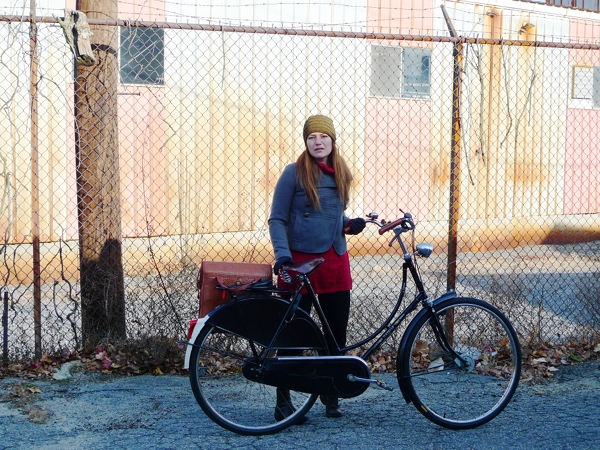 Now that it's winter, I find that strangers talk to me more than usual about cycling - typically when they see me locking up my bike. Over the past couple of weeks, several women have told me that they'd love to ride a bike, but find the logistics daunting: having to buy lights and figure out how to mount them; constantly getting flats (something they remember from previous cycling experiences); having to figure out how to carry their handbag, struggling to mount the bike in business attire, and other similar concerns. Their misgivings are fueled by the perception that cycling will complicate their lives - compared to walking, or taking public transportation, or driving.
Now that it's winter, I find that strangers talk to me more than usual about cycling - typically when they see me locking up my bike. Over the past couple of weeks, several women have told me that they'd love to ride a bike, but find the logistics daunting: having to buy lights and figure out how to mount them; constantly getting flats (something they remember from previous cycling experiences); having to figure out how to carry their handbag, struggling to mount the bike in business attire, and other similar concerns. Their misgivings are fueled by the perception that cycling will complicate their lives - compared to walking, or taking public transportation, or driving.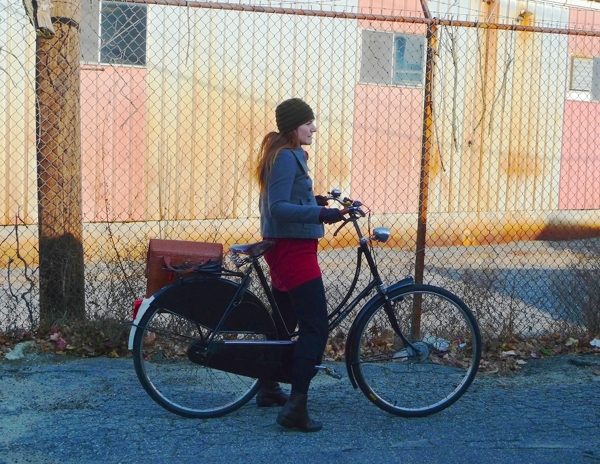 What frustrates me about this, is that all of their concerns can be addressed with the right bike. As I explain about step-through frames, dynamo lighting, tires with puncture-protection, dress guards, chain cases, and panniers that attach to the bicycle's rack in seconds, I can see the ladies' faces light up as they eye these features hungrily.
What frustrates me about this, is that all of their concerns can be addressed with the right bike. As I explain about step-through frames, dynamo lighting, tires with puncture-protection, dress guards, chain cases, and panniers that attach to the bicycle's rack in seconds, I can see the ladies' faces light up as they eye these features hungrily.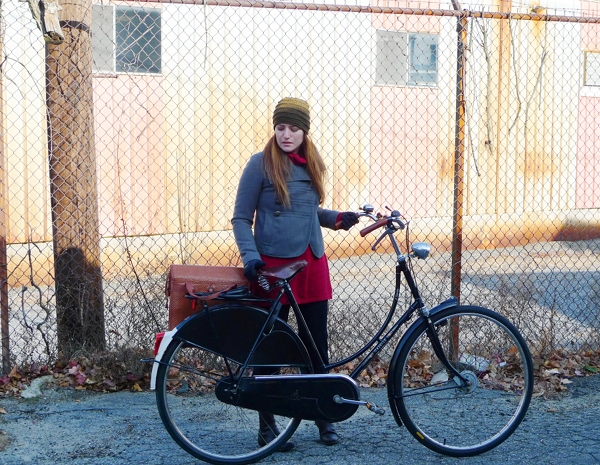 Even though I enjoy learning about bicycle design and own multiple bikes on which I constantly experiment, I am first and foremost a "transportation cyclist." My main priority is to have that one bike that is reliable, comfortable, and as low-maintenance as possible. The bicycle I use for transportation needs to make life easy for me. It needs to minimise the extent to which I think about it and tinker with it - so that I can focus on work and life itself, not on the bicycle. Skirt suit? Heavy bag? Dark outside? Raining like crazy? The "user friendly interface" on my machine accommodates all of these scenarios.
Even though I enjoy learning about bicycle design and own multiple bikes on which I constantly experiment, I am first and foremost a "transportation cyclist." My main priority is to have that one bike that is reliable, comfortable, and as low-maintenance as possible. The bicycle I use for transportation needs to make life easy for me. It needs to minimise the extent to which I think about it and tinker with it - so that I can focus on work and life itself, not on the bicycle. Skirt suit? Heavy bag? Dark outside? Raining like crazy? The "user friendly interface" on my machine accommodates all of these scenarios.




 This quote shares the same sentiments that I felt while looking at these homes:
This quote shares the same sentiments that I felt while looking at these homes: Home is not where you live, but where they understand you. Christian Morganstern
Home is not where you live, but where they understand you. Christian Morganstern Living the life in Virginia!
Living the life in Virginia!